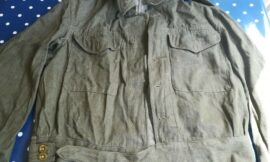The L85A1, part of the SA80 family of firearms, is a British assault rifle that entered service in the late 1980s as a replacement for the aging L1A1 Self-Loading Rifle (SLR). Designed by the Royal Small Arms Factory (RSAF) Enfield, the L85A1 represented a significant departure from previous British small arms designs, incorporating modern materials and a bullpup configuration.
Historical Background
The development of the L85A1 began in the 1970s as part of the SA80 program aimed at modernizing the British Army’s infantry weapons. The goal was to adopt a new rifle chambered in the NATO standard 5.56×45mm cartridge, improving firepower and standardizing with other NATO allies. The L85A1 was officially adopted in 1985 and began service shortly thereafter.
Design and Features
The L85A1 incorporates several notable design features:
- Bullpup Configuration: Unlike traditional rifles where the action and magazine are forward of the trigger, the L85A1 is a bullpup design, with the action and magazine located behind the trigger. This design allows for a shorter overall length while maintaining a full-length barrel, enhancing maneuverability in confined spaces such as urban environments.
- 5.56×45mm NATO Chambering: The rifle uses the NATO standard intermediate cartridge, providing good range, accuracy, and manageable recoil suitable for infantry engagements.
- Gas-Operated, Rotating Bolt Mechanism: The L85A1 operates on a gas-operated system with a rotating bolt, common in modern assault rifles. This mechanism ensures reliable cycling of the action and good accuracy.
- Integrated Optical Sight (SUSAT): The L85A1 was initially equipped with the Sight Unit Small Arms Trilux (SUSAT), an integrated optical sight mounted on top of the receiver. This sight improved target acquisition and accuracy over iron sights.
- Ergonomics: The rifle was designed to be ergonomic and user-friendly, with controls and features accessible to the operator. It features a pistol grip and ambidextrous safety and magazine release.
Issues and Controversies
Despite its innovative design, the L85A1 faced significant issues and controversies during its early years of service:
- Reliability Problems: The L85A1 was plagued by reliability issues, including stoppages, malfunctions, and parts breakage. These problems were attributed to poor manufacturing quality, design flaws, and insufficient testing before deployment.
- Operational Criticism: Soldiers criticized the L85A1 for its poor performance in harsh environments, including desert operations during the Gulf War. Dust and sand could easily cause the rifle to jam or malfunction.
- Public and Political Scrutiny: The reliability issues with the L85A1 led to public and political scrutiny in the UK, questioning the effectiveness and suitability of the rifle for military service.
Military Use and Upgrades
Despite its problems, the L85A1 was issued to British Army infantry units and saw operational use in various deployments:
- Gulf War: Deployed during the Gulf War in 1990-1991, where its reliability issues were highlighted in combat conditions.
- Balkans Conflict: Used in peacekeeping and combat roles during the conflicts in the Balkans in the 1990s.
Replacement and Upgrades
In response to the criticisms and operational issues, efforts were made to improve the L85A1:
- L85A2 Upgrade: By the early 2000s, the L85A1 underwent a comprehensive refurbishment program to address reliability issues and improve overall performance. The upgraded version, known as the L85A2, featured numerous improvements, including better quality control in manufacturing, redesigned components, and improved ergonomics.
- Success and Continued Service: The L85A2 variant proved to be significantly more reliable and effective than its predecessor. It remains in service with the British Armed Forces, demonstrating its capability in modern combat environments.
Legacy and Influence
The L85A1, despite its troubled introduction, contributed to advancements in British small arms design and doctrine:
- Lesson Learned: The experience with the L85A1 highlighted the importance of rigorous testing, quality control in manufacturing, and user feedback in weapon development programs.
- Cultural Impact: The L85A1 has become a symbol of the challenges and lessons learned in modernizing military equipment.
Conclusion
The L85A1, while initially beset by reliability issues and criticism, evolved into a more reliable and effective rifle through subsequent upgrades and improvements. Its journey from troubled beginnings to continued service with upgrades underscores the complexities and challenges of modern infantry weapon development and deployment.


